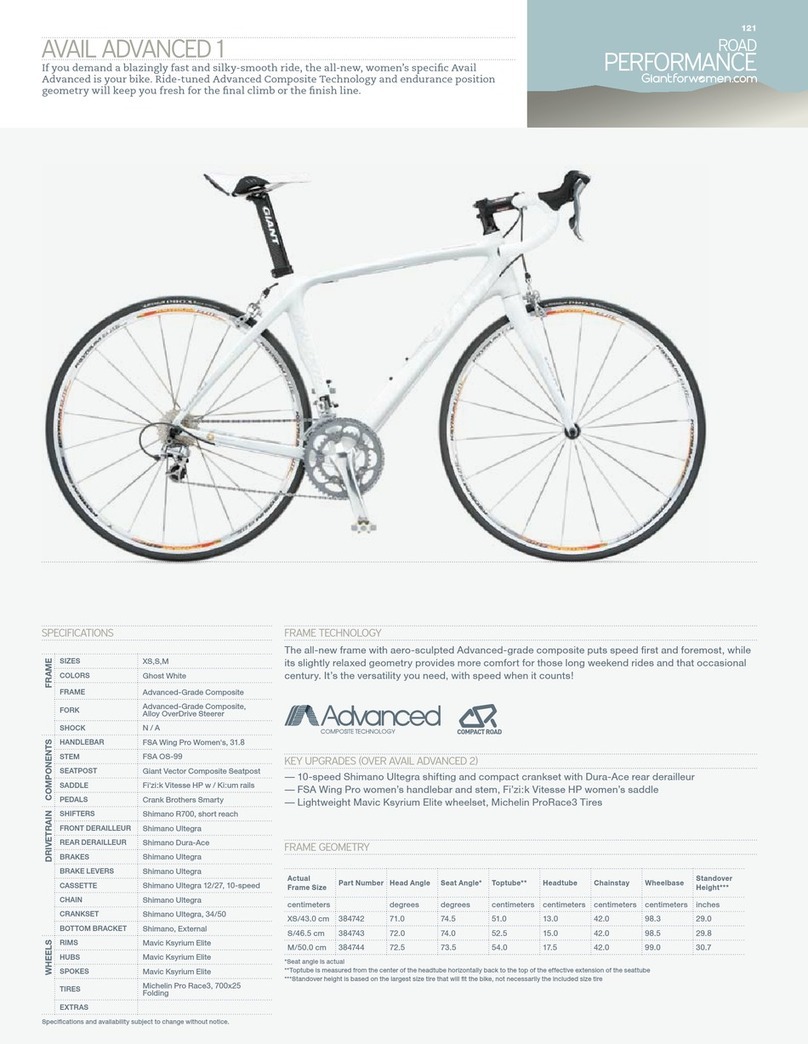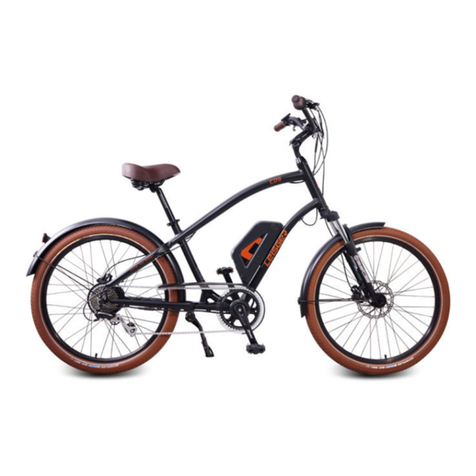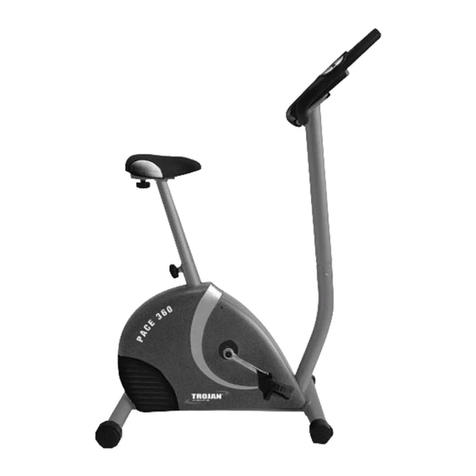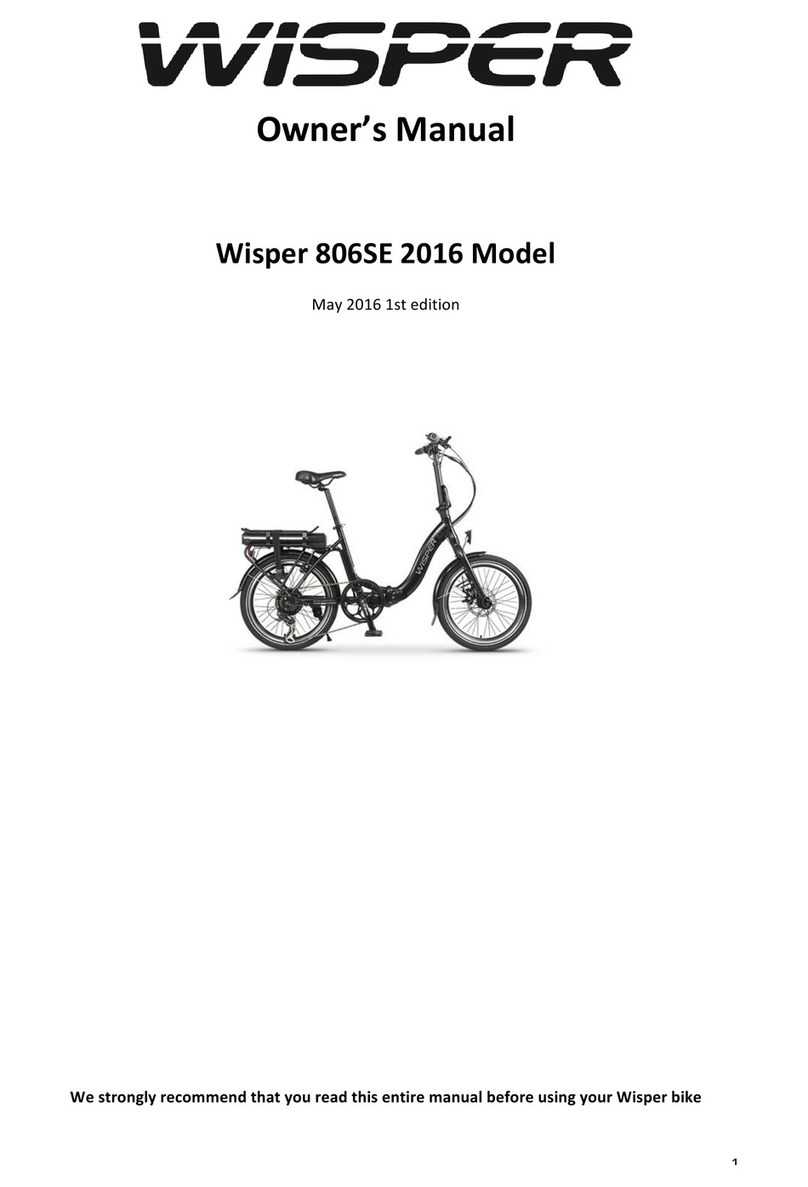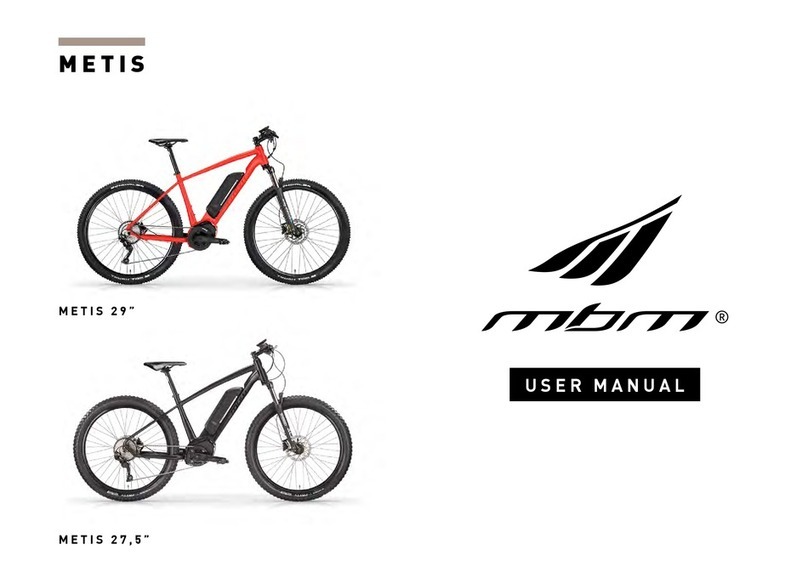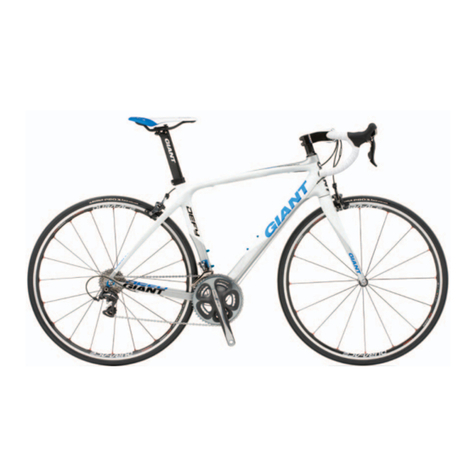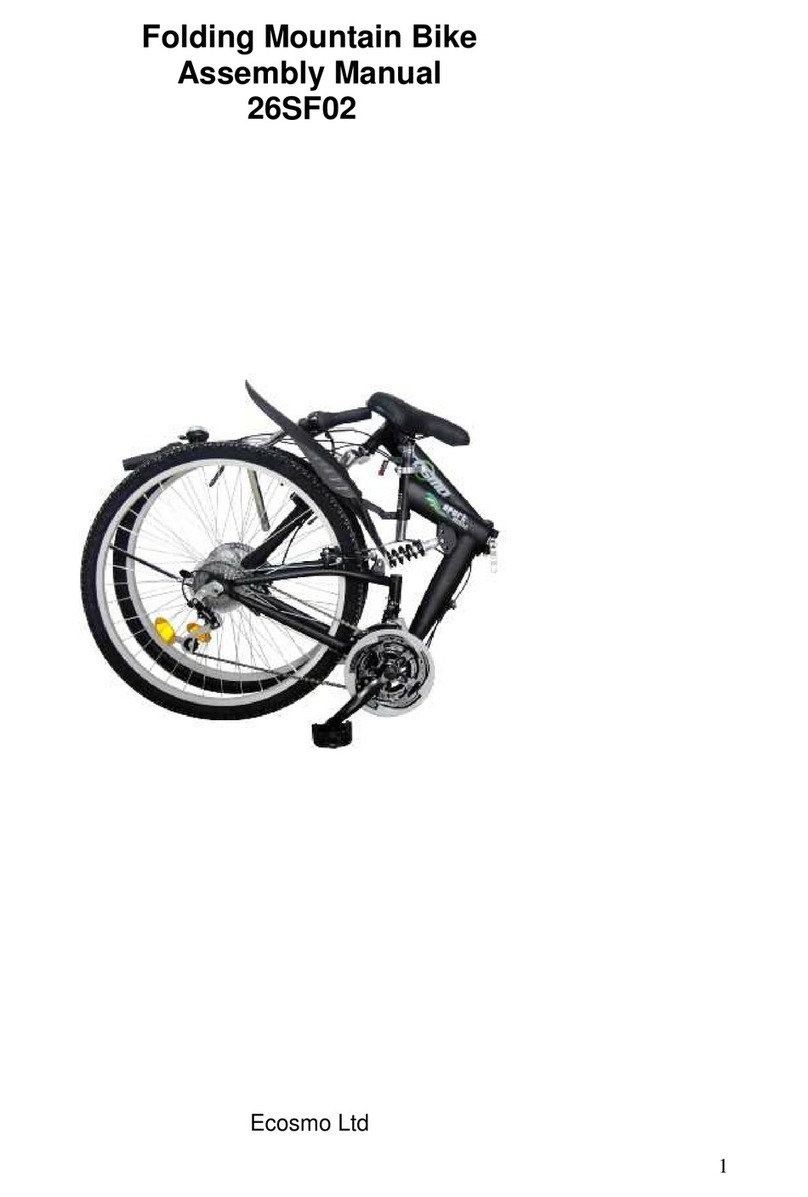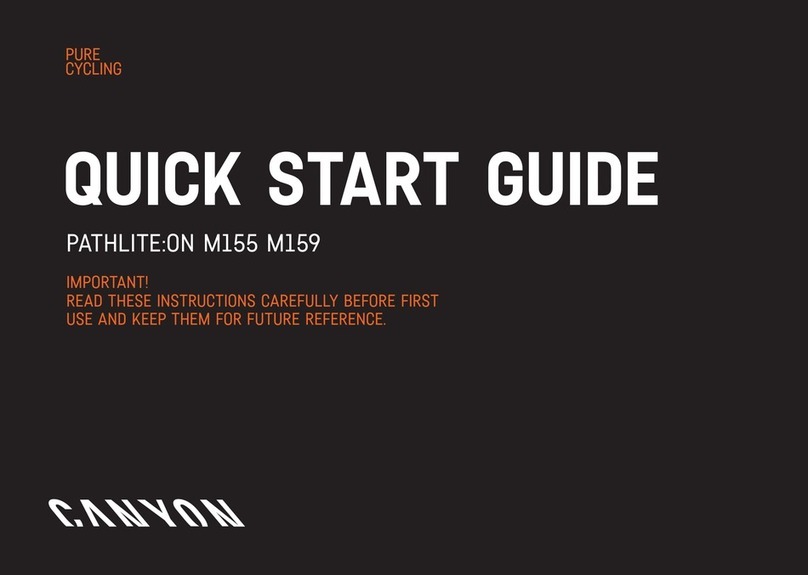Advanced COMFORT User manual

1002021-01 | 01.2022
ORIGINAL INSTRUCTIONS
COMFORT URBAN TOUR TREKKING OFFROAD



4
ORIGINAL INSTRUCTIONS | ADVANCED | 01.2022 | 1002021-01
5 Brakes ............................................................... 23
5.1 Brake lever assignment.......................................... 23
5.2 Brake warnings...............................................................23
5.3 Disc brake...........................................................................24
5.4 Coaster brake .................................................................28
6 Gear shift ........................................................29
6.1 Derailleur gear system........................................... 30
6.2 Hub gear system .......................................................... 31
7 Wheels .............................................................. 33
7.1 General information..................................................33
7.2 Warnings about the wheels ...............................35
7.3 Inflating tyres..................................................................36
7.4 Checking wheels ..........................................................36
Contents
1 Notes on the original operating
instructions................................................................7
1.1 Basic information ............................................................7
1.2 Read and keep the instructions.........................7
1.3 Symbols and illustrations...................................................7
1.4 Importance of
safety and warning notices ..................................8
2 Security.............................................................. 8
2.1 Type plate and identification..............................8
2.2 Intended use.....................................................................10
2.3 Residual risks................................................................... 12
2.4 Safety instructions .................................................... 12
3 Components/structure ............................. 15
4 Drive................................................................... 16
4.1 Chain drive.........................................................................16
4.2 Belt drive..............................................................................18
4.3 E-drive ................................................................................... 21

5
ORIGINAL INSTRUCTIONS | ADVANCED | 01.2022 | 1002021-01 www.advanced.tech
8 Suspension.......................................................37
8.1 Function and terms....................................................38
8.2 Suspension warnings................................................38
8.3 Suspension seat post ..............................................39
8.4 Suspension rear triangle .......................................39
8.5 Suspension fork............................................................40
8.6 Maintaining spring-loaded
components......................................................................41
9 Saddle ...............................................................42
9.1 Warnings about saddle adjustment...........42
9.2 Adjusting the saddle.................................................42
9.3 Lowerable seat post .................................................45
10 Handlebars......................................................46
10.1 Adjusting the handlebars.................................... 46
11 Lighting............................................................48
11.1 Warning notices for lighting..............................49
11.2 Switching the lighting on and off .................49
12 Bell..................................................................... 50
13 Luggage carrier ........................................... 50
14 Stand................................................................. 51
15 Lock (immobiliser)....................................... 51
16 Quick release ................................................. 51
16.1 Opening/closing the quick release.............. 51
16.2 Adjusting the quick release ...............................52
17 Storage.............................................................53
17.1 Recommissioning.........................................................53
18 Transport.........................................................54
19 Using the e-bike...........................................55
19.1 Preparation........................................................................55
19.2 Check before each ride...........................................57
19.3 Riding the e-bike ..........................................................57
19.4 Transporting luggage...............................................58
19.5 After a fall...........................................................................59

6
ORIGINAL INSTRUCTIONS | ADVANCED | 01.2022 | 1002021-01
20 Maintenance ................................................. 60
20.1 Cleaning and care......................................................60
20.2 Regular inspection and maintenance......60
20.3 Faults and repairs........................................................ 61
20.4 Torque specifications .............................................. 61
21 Service..............................................................62
21.1 Customer service.........................................................62
21.2 Spare parts........................................................................62
21.3 Download portal............................................................62
21.4 Final decommissioning / disposal..................63
22 EC Declaration of Conformity................64
23 E-Bike Passport............................................65
24 Professional maintenance /
inspection........................................................66

7
ORIGINAL INSTRUCTIONS | ADVANCED | 01.2022 | 1002021-01 www.advanced.tech
Notes on the original operating instructions
1 Notes on the original operating
instructions
1.1 Basic information
These original operating instructions (hereinafter referred to
as the "instructions") belongs to your e-bike. The model ver-
sion of your e-bike can be found on the type plate (→ Chap-
ter 2.1 „Type plate and identification“).
The instructions use the term "e-bike". Each e-bike descri-
bed here is an EPAC (Electrically Power Assisted Cycle)
according to EN 15194:2017.
In addition to these instructions, the manufacturer's
instructions for the e-drive and, if applicable, other
manufacturer's instructions for the components installed on
your e-bike are enclosed with your e-bike. All documents
together form the overall scope of the original operating
instructions and must be observed when handling the e-bike
in order to minimise risks.
You can also download these instructions and all other
applicable documents from our download portal (→ Chap-
ter 21.3 „Download portal“).
1.2 Read and keep the instructions
This manual contains all the important information on the
safetyand use of your e-bike. It is based on the specifications
valid in the European Union.
Read the complete instructions carefully before using your
e-bike for the first time.
If you do not follow the instructions, you may injure yourself
and other persons and/or cause damage to property.
Always keep this manual handy for further use and give the
manual with you when you pass your e-bike on to third
parties.
1.3 Symbols and illustrations
This manual uses the following symbols.
Additional information and tips.
Advice for environmentally sound use.
All illustrations in this manual are of an exemplary nature;
therefore individual details on your e-bike may look different
from these exemplary illustrations.
The illustrations used are for understanding function and
operation, as well as maintenance and cleaning activities.
Directional information (e.g. right/left) always refers
to the direction of travel forwards.

8
Security
ORIGINAL INSTRUCTIONS | ADVANCED | 01.2022 | 1002021-01
1.4 Importance of safety and warning
notices
Safety instructions and warnings serve to ensure the safe
operation and proper functioning of your e-bike. Both types
of information describe hazards that may occur when
handling or using your e-bike and provide instructions for
avoiding the corresponding hazard.
The safety instructions are summarised in the "Safety"
section and contain basic instructions for the safe use of
your e-bike.
The warnings for handling the individual e-bike components
can be found in the chapters on the respective component.
Depending on the possible consequences of non-
compliance, warning notices in this manual are marked as
follows:
WARNING
Possible danger to life or serious injury.
CAUTION
Possible minor injuries.
NOTE
Damage to the e-bike or the surroundings.
2 Security
2.1 Type plate and identification
The specific type plate of your e-bike is located on the
frame.
The type plate contains all the relevant data about
your e-bike, e.g.:
• Permissible total weight (driver + luggage).
• Dead weight of the e-bike.
• Details regarding the installed electric drive.
fRefer to the following illustration for the structure of the
type plate and the information on it.
fIf you have any questions or uncertainties regarding
your e-bike model, the model-specific equipment or
(model-specific) equipment details, contact the
customer service of
E BIKE ADVANCED TECHNOLOGIES GMBH or your
bicycle dealer for ADVANCED brand e-bikes.

9
ORIGINAL INSTRUCTIONS | ADVANCED | 01.2022 | 1002021-01 www.advanced.tech
Security
2
3
8
74
6
5
1
Abb.: 1 Type plate
1. Model
2. Frame number
3. Intrinsic weight of e-bike
4. Engine power of the e-drive
5. E-drive cut-off speed
6. Manufacturer
7. Permissible total weight (Advanced E-Bike + driver + luggage)
8. Year of manufacture

10
Security
ORIGINAL INSTRUCTIONS | ADVANCED | 01.2022 | 1002021-01
2.2 Intended use
All e-bikes described in this manual are designed for use
under specific conditions. Depending on the use for which
your e-bike is designed, specific requirements for
components, material, etc. for the corresponding area of use
have been taken into account in the design to maximise
product safety and riding comfort.
fOnly use the e-bike for its intended use and purpose!
If not used as intended, you risk components not being able
to cope with the requirements and failing. They can cause
accidents, serious injuries and damage to the e-bike.
The manufacturer and dealer accept no liability for damage
caused by improper use. Likewise, your warranty claim expi-
res if the e-bike is not used for its intended purpose.
The following applies to all e-bikes described in this
manual:
• Your e-bike is designed for one cyclist.
• The seat position must be adjusted for the cyclist.
• The maximum permissible total weight for the e-bike
must not be exceeded.
• When participating in road traffic, the country-specific
and regional regulations must be taken into account.
• The e-bikes are not approved for use with a child seat
and/or trailer (child, cargo, dog trailer, etc.).
For further information on the intended use for the category
of your e-bike, please refer to the table below.
You can find the category of your e-bike on the sti-
cker on the frame.
fContact your bicycle dealer if you are unsure or do not
know which category your e-bike belongs to.

11
ORIGINAL INSTRUCTIONS | ADVANCED | 01.2022 | 1002021-01 www.advanced.tech
Security
Category 1 Category 2 Category 3 Category 4
COMFORT *
URBAN *
TOUR *
TREKKING **
OFFROAD **
TREKKING **
OFFROAD **
OFFROAD **
For use:
• on normal, paved
surfaces (tarred or
paved roads and paths).
Tyres should be in contact
with the ground at average
speed.
• As category 1:
• on gravelled and
unpaved paths with a
medium gradient;
• for jumps from a height
of max. 15 cm. Tyres may
briefly lose contact with
the ground.
• As categories 1 and 2:
• on rough and/or difficult
routes that require
advanced cycling
technique,
• for jumps from a height
of max. 60 cm.
• As categories 1, 2 and 3:
• for descents in rough
terrain with a maximum
speed of 40 km/h,
• for jumps from a height
of max. 120 cm.
Intended drop/jump height:
< 15 cm < 15 cm < 60 cm < 120 cm
Intended use:
• Commuting/leisure
travel with moderate
exertion
• Leisure trips/trekking
with moderate exertion
• Sport and competition
rides with moderate
technical demands of
the trails
• Sport and competition
rides with very
challenging technical
demands of the trails
Recommended operating skills
• No special operating
skills required
• No special operating
skills required
• Technical skills and
practice required
• Technical skills, practice
and good bike control
required
* All COMFORT and URBAN bikes are category 1; all TOUR bikes are category 2.
** Observe the sticker on the e-bike: TREKKING and OFFROAD bikes fall into different categories depending on the model.

12
Security
ORIGINAL INSTRUCTIONS | ADVANCED | 01.2022 | 1002021-01
Possible examples of improper use are:
• Manipulation or modification of the e-drive (tuning).
• Impermissible use with child seat and/or bicycle trailer
(e.g. child or cargo trailer).
2.3 Residual risks
Certain risks remain when using the e-bike, but can be redu-
ced by following the safety and warning instructions.
These usually include:
• Unpredictable driving manoeuvres and/or misbehaviour
of other road users;
• Surprising or sudden changes in the characteristics of
the road surface, e.g. freezing wetness or "black ice";
• Incalculable material defects or signs of wear/resulting
breakage or functional impairment of components.
2.4 Safety instructions
To reduce the general risk of accidents and injuries when
riding an e-bike:
fDo not use the e-bike until you are familiar with its
handling and function.
fObserve the intended use.
fDrive with foresight.
fAdjust driving style/speed to the current weather
conditions and road characteristics.
fOn slippery, wet, slippery or dirty roads, allow for longer
braking distance/reduced tyre grip.
fShow consideration for other road users/drive defensi-
vely.
fCheck the e-bike before each use (visual inspection).
Pay attention to, among other things: Cracks, grooves,
damage or colour changes on components.
fAlways ensure that safety-relevant devices (e.g. brakes)
are correctly adjusted and in working order. Do not use
the e-bike if safety-relevant components are damaged
or do not function properly.
fNever replace components on the e-bike or make
modifications or repairs yourself.
Damage to the e-bike should always be repaired by the
bicycle dealer, and damaged components should
always be replaced with suitable original spare parts.

13
ORIGINAL INSTRUCTIONS | ADVANCED | 01.2022 | 1002021-01 www.advanced.tech
Security
fIn case of any uncertainty/confusion regarding the
procedures described here, contact a bicycle dealer.
fAfter an accident/fall or if your e-bike has been
subjected to excessive loads, contact a bicycle dealer
for a professional check.
E-bikes operate differently than regular bikes without
e-drive:
fDo not underestimate the changed operating behaviour
of e-bikes and the risks they pose.
fPractise typical cycling situations (e.g. starting/braking,
cornering/turning) with the e-bike in the beginning.
fObtain information about any applicable national
regulations for electric motor-assisted bicycles.
To reduce the general risk of accidents and injuries when
driving in road traffic:
fBefore using your e-bike on the road, ensure that it
complies with the country-specific regulations. If
necessary, contact your bicycle dealer for more
information.
fObserve country-specific and regional road traffic
regulations. Information on current road traffic regulati-
ons in the country/region can be obtained, for example,
from the Ministry of Transport.
fWear a suitable bicycle helmet when riding (with CE
mark, tested according to DIN EN 1078).
fWear light-coloured clothing and reflectors when
driving.
Risk of electric shock and injury if electrical
components/e-drive are handled incorrectly:
fIf possible, always remove the battery before working
on the e-bike/transporting the e-bike.
fDo not make any modifications/manipulations to the
e-drive. NO tuning of the drive!
fAny necessary repairs to the electric drive must only be
carried out by a specialist (using original spare parts).
fUse the "Push Assist" function only for pushing. Hold
the e-bike securely with both hands, wheels must be in
contact with the ground.
Incorrect handling can cause batteries to explode or burn:
fKeep battery away from open fire/other heat sources.
fDo not store the removable battery near metal objects
(e.g. coins, paper clips, screws, etc.). Danger of short
circuit!
Dangers with damaged batteries:
fHave the battery checked after falls/hard knocks.
fNever open, disassemble, pierce or deform the battery.
fOnly touch damaged batteries when wearing protective
gloves. Danger of burns from contact with leaking
battery fluid!

14
Security
ORIGINAL INSTRUCTIONS | ADVANCED | 01.2022 | 1002021-01
fIn case of contact with battery acid, immediately rinse
the affected area thoroughly with water and then
consult a doctor (especially in case of eye contact).
fWhen the battery is on fire: Immediately move to a safe
distance, shield the area surrounding the fire and, if
possible, call the fire brigade. Do not attempt to extin-
guish the burning battery yourself with water!
Risk of injury when riding in unsuitable clothing:
fIf possible, wear tight-fitting clothes instead of loose
trousers, dresses or skirts.
fEnsure that loose clothing cannot get caught in the
moving parts (e.g. with trouser clips).
fDo not leave loose ribbons, shoelaces or similar han-
ging down.
fWear shoes with non-slip soles to avoid slipping off the
pedal.
Risk of damage if not used as intended:
fAlways observe the permissible total weight of the
e-bike (including the cyclist and luggage, if applicable).
The permissible total weight must not be exceeded!
fEnsure that the tyre inflation pressure is set correctly;
adjust if necessary.
fDo not drive through deep water if inadmissible accor-
ding to intended use.

15
ORIGINAL INSTRUCTIONS | ADVANCED | 01.2022 | 1002021-01 www.advanced.tech
Components/structure
3 Components/structure
This figure shows an example of the Trekking Pro X
Wave e-bike model.
21
4
5
67
16
3
9
8
12
13 14
11
10
15
Abb.: 2 General overview
1. Handlebar stem
2. Handlebar with controls
3. Front wheel fork
4. Front wheel
5. Brake disc (front wheel brake)
6. Pedal
7. Pedal crank
8. Belt (belt drive)/chain (chain drive)
9. Rear wheel hub
10. Brake disc (rear wheel brake)
11. Rear wheel
12. Luggage carrier (rear)
13. Saddle
14. Seat post
15. Lock (immobiliser)
16. Downtube (including the battery mount)

16
Drive
ORIGINAL INSTRUCTIONS | ADVANCED | 01.2022 | 1002021-01
4 Drive
fRead and follow chapter "Chain drive" if your e-bike has
a chain.
fIn addition, read and follow the chapter "E-drive" and
the manufacturer's instructions for the e-drive.
or
fRead and follow chapter "Belt drive" if your e-bike has a
belt.
fIn addition, read and follow the chapter "E-drive" and
the manufacturer's instructions for the e-drive.
4.1 Chain drive
The chain runs over two toothed gears (front toot-
hed gear = chain ring; rear toothed gear = sprocket).
A chain can be opened, closed again and extended.
3 1 2
Abb.: 3 Chain drive components
1. Chain
2. Chain ring
3. Sprocket
(model-dependent number)

17
ORIGINAL INSTRUCTIONS | ADVANCED | 01.2022 | 1002021-01 www.advanced.tech
Drive
4.1.1 Wear and maintenance
Wear on the chainring/sprocket means that the chain is gui-
ded less reliably over the corresponding toothed gear and
can therefore jump off.
Worn chain links widen the free openings to accommodate
the teeth so that the chain is guided less reliably over the
chain ring and sprocket and can jump off. The impression
may arise that the chain has widened.
fCheck rhw chain ring, sprocket and chain regularly for
signs of wear (visual inspection).
fHave worn chain rings or sprockets replaced by a
bicycle dealer.
fHave the chain correctly adjusted or replaced by the
bicycle dealer if it appears that the chain has widened
or the chain/chain links show signs of wear.
3 1 2
Abb.: 4 Possible wear on the chain drive
1. Chain
2. Chain ring
3. Sprocket
4.1.2 Cleaning and care
fKeep the components of the chain drive free of dirt and
clean them regularly to avoid loss of function of the
chain drive.
fClean the chain with a clean, lightly oiled cloth.
fClean the chain ring and sprocket with a soft brush.

18
Drive
ORIGINAL INSTRUCTIONS | ADVANCED | 01.2022 | 1002021-01
fGrease the chain with universal oil:
–after you have cleaned the chain,
–if the chain has become (excessively) wet,
–regularly about every 15 operating hours.
fEnsure that the components of the chain drive are
undamaged.
fIn case of more stubborn dirt or damage to the chain
drive, consult a bicycle dealer.
4.2 Belt drive
The belt runs over the front and rear pulley.
A belt cannot be opened and closed again and can-
not be extended or shortened.
3 1 2
Abb.: 5 Components of the belt drive
1. Belt
2. Front pulley
3. Rear pulley
fWhen handling the belt, observe the following note and
associated pictograms to avoid damage to the belt/
loss of function of the belt drive.

19
ORIGINAL INSTRUCTIONS | ADVANCED | 01.2022 | 1002021-01 www.advanced.tech
Drive
NOTE
Risk of damage
Incorrect handling can damage the belt. Some damage
(e.g. torn carbon fibres inside the belt) is not visible from
the outside, but it can cause the belt to lose tensile
strength and/or tear.
fDo not kink, bend, twist, lace, turn upside down or use
as a belt whip.
fDo not force the belt onto or off the pulley. The belt
must be placed on the pulley without tension; the belt
tension is only established after it has been placed on
the pulley.
fDo not handle sharp-edged objects or tools on the
belt.
fDo not oil or grease the belt drive.
fDo not open or mend straps.
fNever stand on the belt. Do not allow any external
load to act on the belt (e.g. when the e-bike is parked).
fNever hold the e-bike by the belt.
fHave the belt replaced if it no longer runs securely on
the pulley.
Abb.: 6 Pictograms of belt handling

20
Drive
ORIGINAL INSTRUCTIONS | ADVANCED | 01.2022 | 1002021-01
4.2.1 Wear and maintenance
Worn cams on the pulleys can damage the belt. The belt is
also guided less reliably over the pulleys and can slip off.
If the cams on the belt are worn, damaged or torn, the belt
is less reliably guided over the pulleys and can easily slip off
or "jump over". A worn belt can tear.
fCheck pulleys and belts regularly for signs of wear
(visual inspection).
fHave worn pulleys replaced by the bicycle dealer.
fHave worn belt replaced by bicycle dealer.
3
1
2
Abb.: 7 Possible signs of wear on the belt drive
1. Belt
2. Front pulley
3. Rear pulley
4.2.2 Cleaning and care
fKeep components of the belt drive free of dirt or clean
them regularly and check the belt tension regularly to
avoid loss of function of the belt drive.
fClean the profiles of the belt and pulleys with a soft
brush.
This manual suits for next models
4
Table of contents

